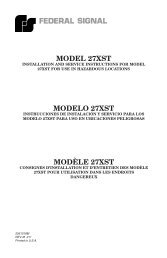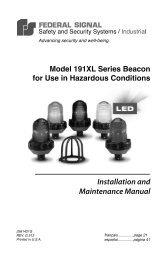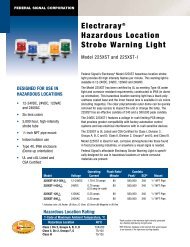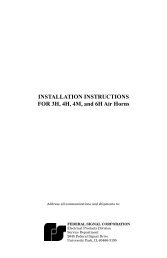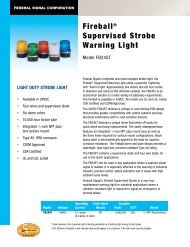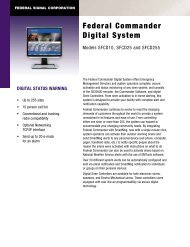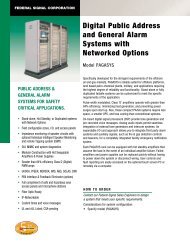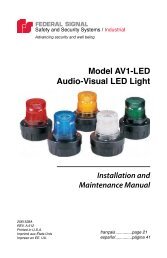UltraVoice Manual - Alerting & Notification
UltraVoice Manual - Alerting & Notification
UltraVoice Manual - Alerting & Notification
Create successful ePaper yourself
Turn your PDF publications into a flip-book with our unique Google optimized e-Paper software.
Federal Signal <strong>UltraVoice</strong><br />
Installation and Operation <strong>Manual</strong><br />
SECTION VI<br />
PRE-OPERATION CHECKOUT AND TEST<br />
Note: See UV RTU Field Service Data Sheet located at the end of this section. This is<br />
the suggested data sheet that can be used to test the siren.<br />
6.0 Amplifier and Speaker<br />
Pre-Operation Checkout<br />
With an ohmmeter capable of accurately<br />
measuring resistance of less than 10<br />
ohms, hold the meter probes on the<br />
speaker terminal strips at the bottom of<br />
the system motherboard for each<br />
amplifier and measure the resistance at<br />
the output of that amplifier. The<br />
resistance should be approximately 4.5<br />
ohms. A different reading indicates a<br />
possible wiring error or faulty driver in<br />
the speaker array. Since the 400 Watt<br />
speaker circuits are comprised of two<br />
sets of series wired speaker drivers<br />
connected in parallel, if one of the<br />
drivers in a circuit were to open,<br />
approximately 9 ohms would be<br />
measured. If 200 Watt DSA speaker<br />
combinations are used, a 10.8 ohm<br />
reading should be measured across the<br />
200 Watt load.<br />
WARNING<br />
The output sound level of a Modulator<br />
Siren is capable of causing permanent<br />
hearing damage at short distances;<br />
sound levels may exceed 150 dB.<br />
Therefore, ALWAYS wear adequate<br />
hearing protection when performing<br />
tests or maintenance on the siren.<br />
Power should be supplied to the siren<br />
so that the batteries may be charged for<br />
a period of 24 hours prior to operation of<br />
PRE OPERATION CHECKOUT AND TEST<br />
55<br />
the siren in order to ensure full charge of<br />
the batteries. (Alternatively, the batteries<br />
may be charged externally before<br />
installation following battery the battery<br />
manufacturer‟s recommendations.)<br />
Typical battery voltage should be 27.2<br />
VDC when fully charged at room<br />
temperature. (See specification section<br />
for details.)<br />
After the batteries have been charged, a<br />
simple and non-annoying test for siren<br />
operation would be to disconnect all<br />
amplifier terminal strip connectors from<br />
the bottom of the system mother board,<br />
press one of the manual activation<br />
switches to start one of the preprogrammed<br />
functions. The signal A & B<br />
LEDs should light on the control,<br />
indicating that the tone is being<br />
generated from the control module and<br />
the amplifier power and output LEDs<br />
should be lit. Now momentarily insert<br />
the terminal strip connectors<br />
sequentially for each amplifier. You will<br />
hear the siren tone from the speaker<br />
array for the duration of the time that the<br />
connector is installed (amplifier output<br />
points on the connector should read 67<br />
VAC RMS nominally, this level will read<br />
higher when the speakers are removed).<br />
Cancel the signal tone or wait for it to<br />
time out (typically 3 minutes). If you<br />
wish, you may insert all of the terminal<br />
strip connectors and activate any or all<br />
signals for full volume siren testing.



